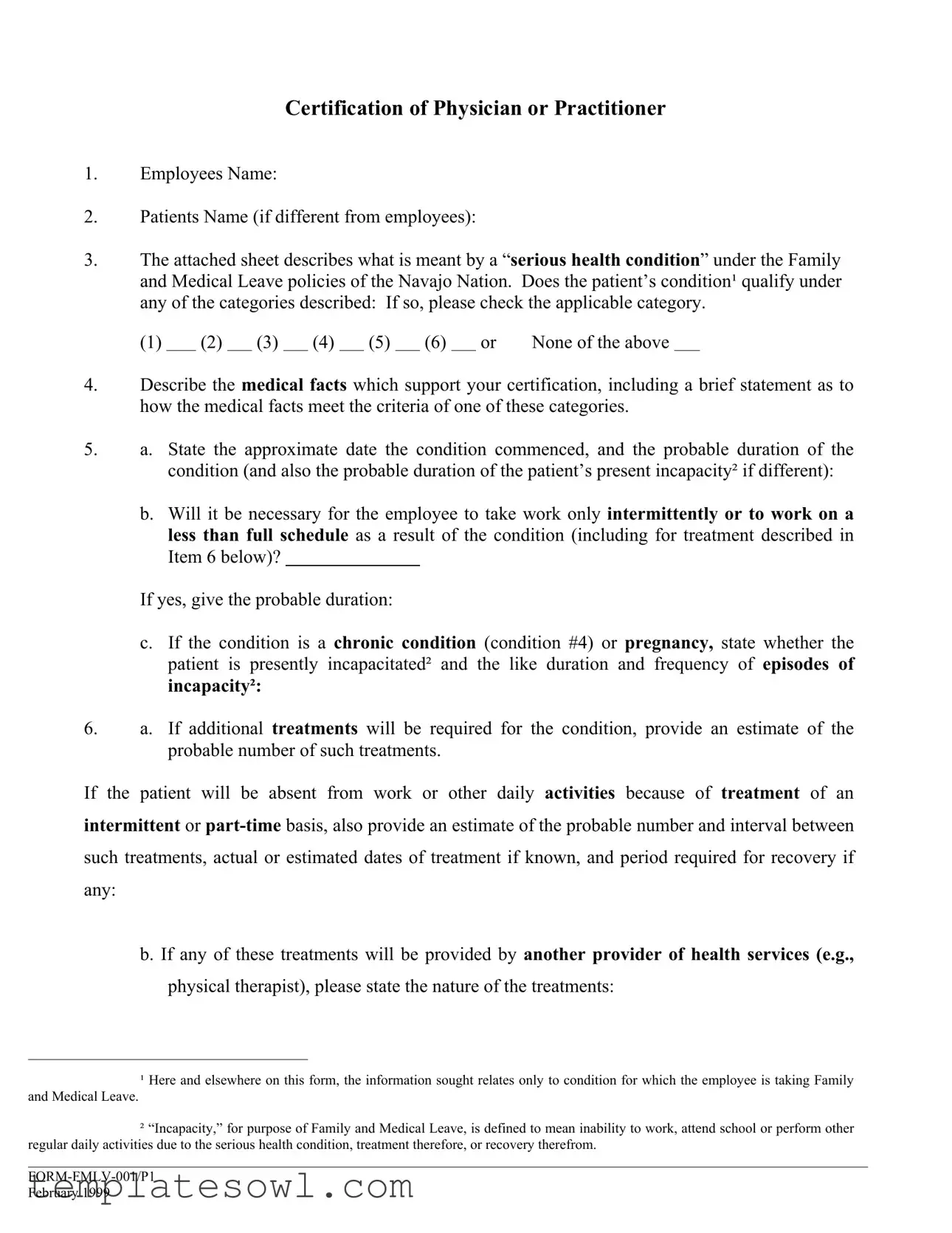Certification of Physician or Practitioner
1.Employees Name:
2.Patients Name (if different from employees):
3.The attached sheet describes what is meant by a “serious health condition” under the Family and Medical Leave policies of the Navajo Nation. Does the patient’s condition¹ qualify under any of the categories described: If so, please check the applicable category.
(1) |
|
(2) |
|
(3) |
|
(4) |
|
(5) |
|
(6) |
|
or |
None of the above |
4.Describe the medical facts which support your certification, including a brief statement as to how the medical facts meet the criteria of one of these categories.
5.a. State the approximate date the condition commenced, and the probable duration of the condition (and also the probable duration of the patient’s present incapacity² if different):
b.Will it be necessary for the employee to take work only intermittently or to work on a less than full schedule as a result of the condition (including for treatment described in Item 6 below)?
If yes, give the probable duration:
c.If the condition is a chronic condition (condition #4) or pregnancy, state whether the patient is presently incapacitated² and the like duration and frequency of episodes of incapacity²:
6.a. If additional treatments will be required for the condition, provide an estimate of the probable number of such treatments.
If the patient will be absent from work or other daily activities because of treatment of an
intermittent or part-time basis, also provide an estimate of the probable number and interval between
such treatments, actual or estimated dates of treatment if known, and period required for recovery if
any:
b. If any of these treatments will be provided by another provider of health services (e.g.,
physical therapist), please state the nature of the treatments:
¹ Here and elsewhere on this form, the information sought relates only to condition for which the employee is taking Family
and Medical Leave.
²“Incapacity,” for purpose of Family and Medical Leave, is defined to mean inability to work, attend school or perform other regular daily activities due to the serious health condition, treatment therefore, or recovery therefrom.
FORM-FMLV-001/P1
February 1999
c.If a regiment of continuing treatment by the patient is required under your supervision, provide a general description of such regiment (e.g., prescription drugs, physical therapy requiring special equipment):
7.a. If medical leave is required for the employee’s absence from work because of the employee’s own condition (including absences due to pregnancy or a chronic condition), is the employee unable to work of any kind:
b.If able to perform some work, is the employee unable to perform any one or more of the essential functions of the employee’s job (the employee or the employer should supply you with information about the essential job functions)?
c.If neither a. or b. applies, is it necessary for the employee to be absent from work for treatment?
8.a. If leave is required to care for a family member of the employee with a serious health condition, does the patient require assistance for basic medical or personal needs or safety, or for transportation?
b.If no, would the employee’s presence to provide psychological comfort be beneficial to the patient or assist in the patient’s recovery?
c.If the patient will need care only intermittently or on a part-time basis, please indicate the probable duration of this need:
(Signature of Health Care Provider) |
|
(Type of Practice) |
|
|
|
(Address) |
(Telephone number) |
To be completed by the employee needing family leave to care for a family member:
State the care you will provide and an estimate of the period during which care will be provided, including a schedule if leave is to be taken intermittently or if it will be necessary for you to work less than a full schedule:
(Employee signature) |
(Date) |
FORM-FMLV-001-P2
February 1999


